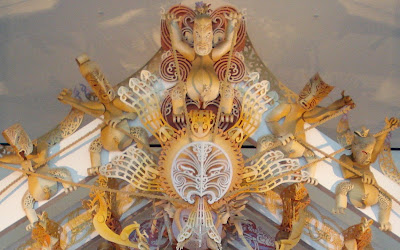
 Māui and his brothers taming the sun - The Marae, Te Papa Museum of New Zealand
Māui and his brothers taming the sun - The Marae, Te Papa Museum of New ZealandThe section I belong to at The Correspondence School (TCS) is called Poutama. We chose this name when restructuring began, with the regionalisation of TCS early last year. I feel privileged to belong to a wonderful section of teachers in Poutama. I’m very proud of our name which comes from the name for an ancient Māori wall design.
Poutama

The Poutama design is a type of tukutuku, a traditional Māori art form. They form part of visual storytelling in Māori culture.
Tukutuku are decorative woven or carved panels that are part of the traditional wall construction used inside Māori meeting houses.
In ancient lore, poutama symbolises an ascent made by the folk hero Tawhaki (pronounced tafaki) to receive the three baskets (kete) of knowledge from the gods.
They are:
- te kete-aronui - basket of knowledge that helps us,
- te kete-tuauri - basket of knowledge to do with ritual, memory and prayer,
- te kete-tuatea - basket of knowledge of evil or makutu, harmful to us.
The construction of poutama symbolises the steps to progress in education and the endeavour to improve - the planning of a child's future - by parents, family and tribe. It is believed to be the ultimate mark of a leader.
The legends of Māui
I have always had a fascination for folk legends. Most Māori legends possess a strong principled or educational aspect. Perhaps this is why I found the legends in Māori folklore particularly absorbing.
Among some of the most attractive are the tales about the Māori half-god, Māui, who was abandoned at birth and later reunited with his family. Māui is depicted with his four brothers in the photo at the head of this post.
Here is how I tell the legend of Māui, how he was eventually reunited with his mother and family, and given his name.
Māui-tikitiki-a-Taranga
Māui wrapped in the topknot of Taranga
Little Māui, baby Māui,
Wrapped all in the tikitiki,
Sleeping on the white wet sand.
Swept the wind up on the beaches,
Swept the ripples, swept the tide-spray,
Hair and seaweed tied the bundle,
Lightly tied the bundle neatly.
Swathed in seaweed, bathed in sea-spray,
Lifted by the tide-wave gently,
Buoyed up on the foamy bubbles,
On he slept as waves were bobbing,
Poor unwanted baby Māui,
Bobbing out to sea.
Still he slept, the little Māui,
As the cruel and hungry sea-birds
Watched the bundle gently rocking,
Rocking on the sea.
Then the kindly sky-god Rangi
Saw the hungry sea-birds hover,
Hover near the baby Māui,
Bobbing out to sea.
Swiftly Rangi hailed the mountains,
Mountains with their white hair gathered,
Gathering the white hair rolling,
Rolling out to sea.
Swift they lifted little Māui,
Lifted on the plumes of white hair,
Hair twined with the tikitiki
High above the sea.
There the kindly Rangi raised him,
Taught him all his wondrous magic,
Set him on the rolling white sand,
Wet sand where Taranga left him.
Then the old man Tama met him,
Took him as his son, his own son,
Told him of his four fine brothers,
Told him of their mother's homeland.
Showed him all he knew as nature,
Where the streams run fast and steeply,
How the bees hive, how they gather,
How the birds dive, how they hover,
Where the fish swim fast and fleetly,
All that he had known.
Then the youthful Māui learning of the homeland,
Yearning for the brothers living with their mother dear,
Left the old man Tama by the rolling white sand,
Crossed the western hills to the wooded plain so near.
Lightly fell the footstep quieter than the silence,
Slipping like a shadow through the shady underwood,
Entering the whare in the family's presence,
Past the smoking fire to where the pitiless mother stood.
Presently Taranga called on all her young ones,
Called on them to join her around the smoking fire,
Counting as they joined hands, counting she had five sons,
Four sons and a strange one dressed in strange attire.
Holding near a fire-brand to the littlest brother
Taranga leaned forward and asked from where he came,
Māui said 'I'm Māui, and you are my own mother',
'These four are my brothers and Taranga's your name'.
Little Māui told them what old Tama told him
Of the baby Māui laid asleep upon the sand:
Shrouded in the seaweed, chilly crown and cold limb,
Rescue, and the sea-birds, and kindly Rangi's hand.
Māui named his brothers and told them all their secrets,
'You are our little Māui!' cried Taranga,
Clasped him to her breast as her hair hung round in ringlets,
Named him little Māui-tikitiki-a-Taranga.
Many other Māori legends can be found on the Māori in Oz site.
This April is National Poetry month in the US.
I have been hopping across to Bud the Teacher and attempting to invoke the muse. It is a wonderful site and Bud is prompting us to write some poetry every day this month.
If you are poetically inclined and would like to write a line or three,
I encourage you to nip across to Bud’s site. Go on. Give opportunity to your muse.







2 comments:
In Ontario we always balance the classical Greek and Roman myths with the Canadian aboriginal tales of the Huron, West Coast, Inuit, Haida... So interesting to read about Maori tradition and your own myth weaving of traditional stories. Also I appreciate the links you provide.
Kia ora Paul.
It's curious how some tales from widely different cultures can be so similar. What distinguishes many Māori tales is their uniqueness, and their direct link to nature and to their way of life.
Catchya later
Post a Comment